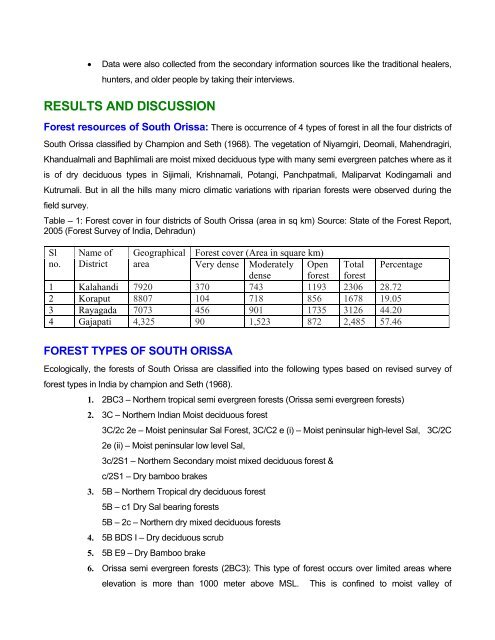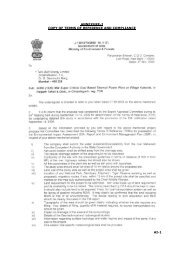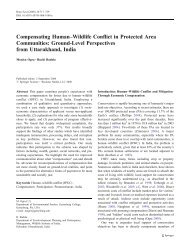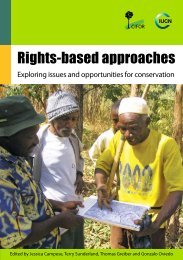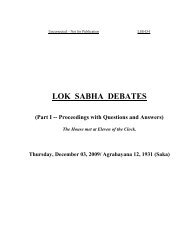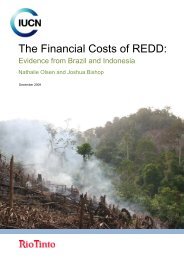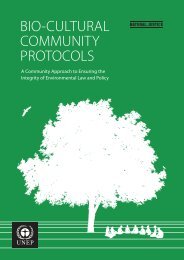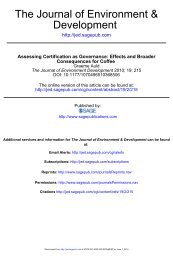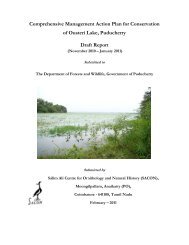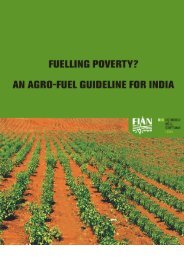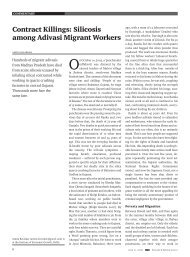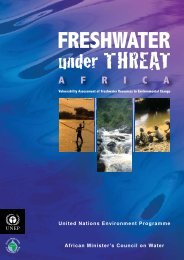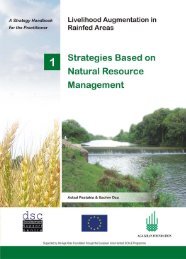biodiversity assessment in some selected hill forests of south orissa
biodiversity assessment in some selected hill forests of south orissa
biodiversity assessment in some selected hill forests of south orissa
Create successful ePaper yourself
Turn your PDF publications into a flip-book with our unique Google optimized e-Paper software.
• Data were also collected from the secondary <strong>in</strong>formation sources like the traditional healers,<br />
hunters, and older people by tak<strong>in</strong>g their <strong>in</strong>terviews.<br />
RESULTS AND DISCUSSION<br />
Forest resources <strong>of</strong> South Orissa: There is occurrence <strong>of</strong> 4 types <strong>of</strong> forest <strong>in</strong> all the four districts <strong>of</strong><br />
South Orissa classified by Champion and Seth (1968). The vegetation <strong>of</strong> Niyamgiri, Deomali, Mahendragiri,<br />
Khandualmali and Baphlimali are moist mixed deciduous type with many semi evergreen patches where as it<br />
is <strong>of</strong> dry deciduous types <strong>in</strong> Sijimali, Krishnamali, Potangi, Panchpatmali, Maliparvat Kod<strong>in</strong>gamali and<br />
Kutrumali. But <strong>in</strong> all the <strong>hill</strong>s many micro climatic variations with riparian <strong>forests</strong> were observed dur<strong>in</strong>g the<br />
field survey.<br />
Table – 1: Forest cover <strong>in</strong> four districts <strong>of</strong> South Orissa (area <strong>in</strong> sq km) Source: State <strong>of</strong> the Forest Report,<br />
2005 (Forest Survey <strong>of</strong> India, Dehradun)<br />
Sl Name <strong>of</strong> Geographical Forest cover (Area <strong>in</strong> square km)<br />
no. District area Very dense Moderately Open Total Percentage<br />
dense forest forest<br />
1 Kalahandi 7920 370 743 1193 2306 28.72<br />
2 Koraput 8807 104 718 856 1678 19.05<br />
3 Rayagada 7073 456 901 1735 3126 44.20<br />
4 Gajapati 4,325 90 1,523 872 2,485 57.46<br />
FOREST TYPES OF SOUTH ORISSA<br />
Ecologically, the <strong>forests</strong> <strong>of</strong> South Orissa are classified <strong>in</strong>to the follow<strong>in</strong>g types based on revised survey <strong>of</strong><br />
forest types <strong>in</strong> India by champion and Seth (1968).<br />
1. 2BC3 – Northern tropical semi evergreen <strong>forests</strong> (Orissa semi evergreen <strong>forests</strong>)<br />
2. 3C – Northern Indian Moist deciduous forest<br />
3C/2c 2e – Moist pen<strong>in</strong>sular Sal Forest, 3C/C2 e (i) – Moist pen<strong>in</strong>sular high-level Sal, 3C/2C<br />
2e (ii) – Moist pen<strong>in</strong>sular low level Sal,<br />
3c/2S1 – Northern Secondary moist mixed deciduous forest &<br />
c/2S1 – Dry bamboo brakes<br />
3. 5B – Northern Tropical dry deciduous forest<br />
5B – c1 Dry Sal bear<strong>in</strong>g <strong>forests</strong><br />
5B – 2c – Northern dry mixed deciduous <strong>forests</strong><br />
4. 5B BDS I – Dry deciduous scrub<br />
5. 5B E9 – Dry Bamboo brake<br />
6. Orissa semi evergreen <strong>forests</strong> (2BC3): This type <strong>of</strong> forest occurs over limited areas where<br />
elevation is more than 1000 meter above MSL. This is conf<strong>in</strong>ed to moist valley <strong>of</strong>


